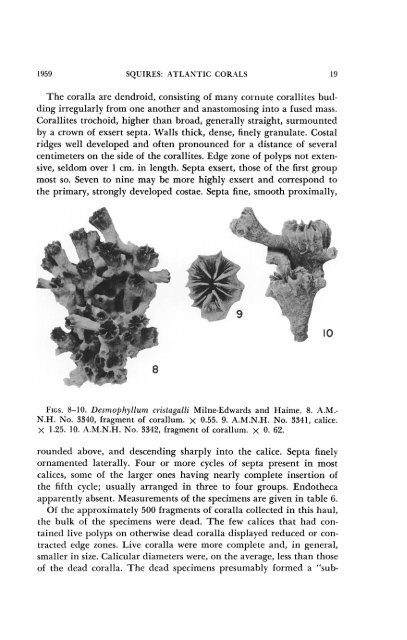MXieuicanJAuscum - American Museum of Natural History
MXieuicanJAuscum - American Museum of Natural History
MXieuicanJAuscum - American Museum of Natural History
Create successful ePaper yourself
Turn your PDF publications into a flip-book with our unique Google optimized e-Paper software.
1959 SQUIRES: ATLANTIC CORALS<br />
19<br />
The coralla are dendroid, consisting <strong>of</strong> many cornute corallites budding<br />
irregularly from one another and anastomosing into a fused mass.<br />
Corallites trochoid, higher than broad, generally straight, surmounted<br />
by a crown <strong>of</strong> exsert septa. Walls thick, dense, finely granulate. Costal<br />
ridges well developed and <strong>of</strong>ten pronounced for a distance <strong>of</strong> several<br />
centimeters on the side <strong>of</strong> the corallites. Edge zone <strong>of</strong> polyps not extensive,<br />
seldom over 1 cm. in length. Septa exsert, those <strong>of</strong> the first group<br />
most so. Seven to nine may be more highly exsert and correspond to<br />
the primary, strongly developed costae. Septa fine, smooth proximally,<br />
FIGS. 8-10. Desmophyllum cristagalli Mile-Edwards and Haime. 8. AM.-<br />
N.H. No. 3340, fragment <strong>of</strong> corallum. x 0.55. 9. A.M.N.H. No. 3341, calice.<br />
X 1.25. 10. A.M.N.H. No. 3342, fragment <strong>of</strong> corallum. X 0. 62.<br />
rounded above, and descending sharply into the calice. Septa finely<br />
ornamented laterally. Four or more cycles <strong>of</strong> septa present in most<br />
calices, some <strong>of</strong> the larger ones having nearly complete insertion <strong>of</strong><br />
the fifth cycle; usually arranged in three to four groups. Endotheca<br />
apparently absent. Measurements <strong>of</strong> the specimens are given in table 6.<br />
Of the approximately 500 fragments <strong>of</strong> coralla collected in this haul,<br />
the bulk <strong>of</strong> the specimens were dead. The few calices that had contained<br />
live polyps on otherwise dead coralla displayed reduced or contracted<br />
edge zones. Live coralla were more complete and, in general,<br />
smaller in size. Calicular diameters were, on the average, less than those<br />
<strong>of</strong> the dead coralla. The dead specimens presumably formed a "sub-
















